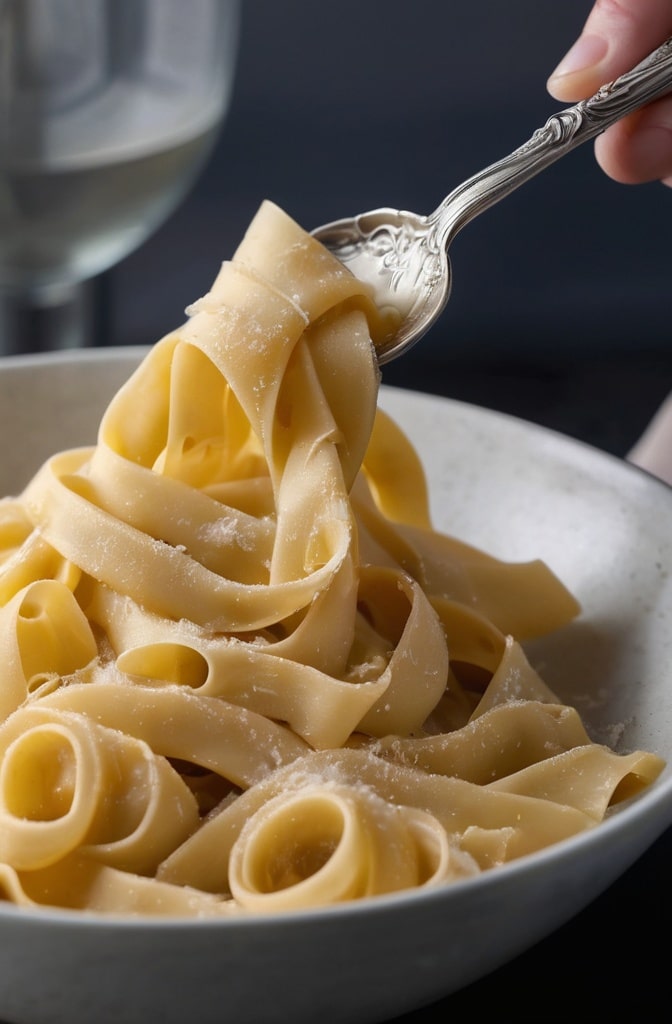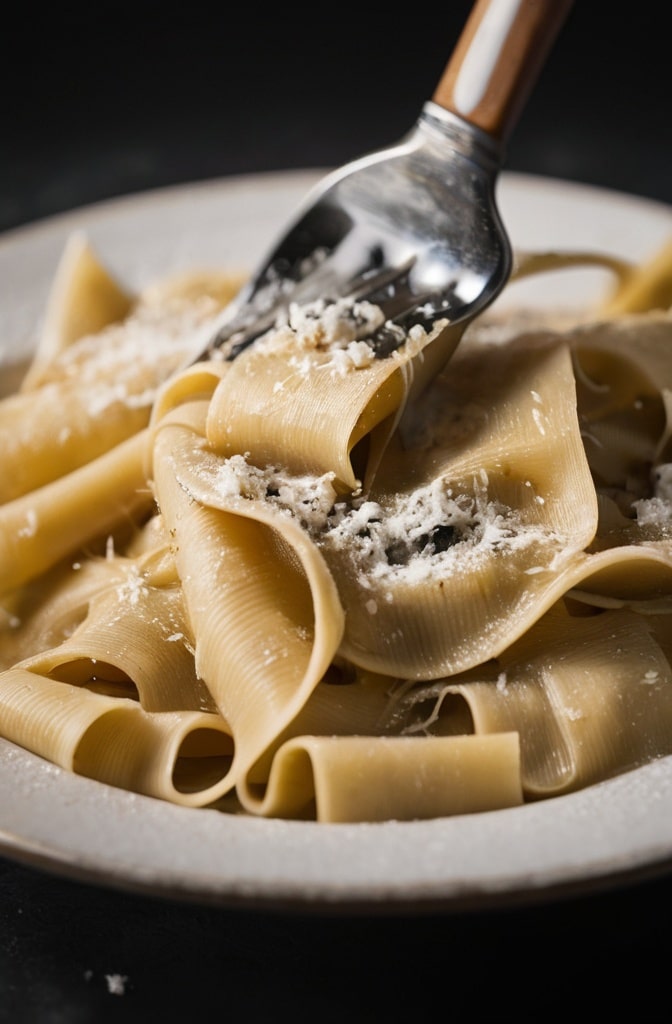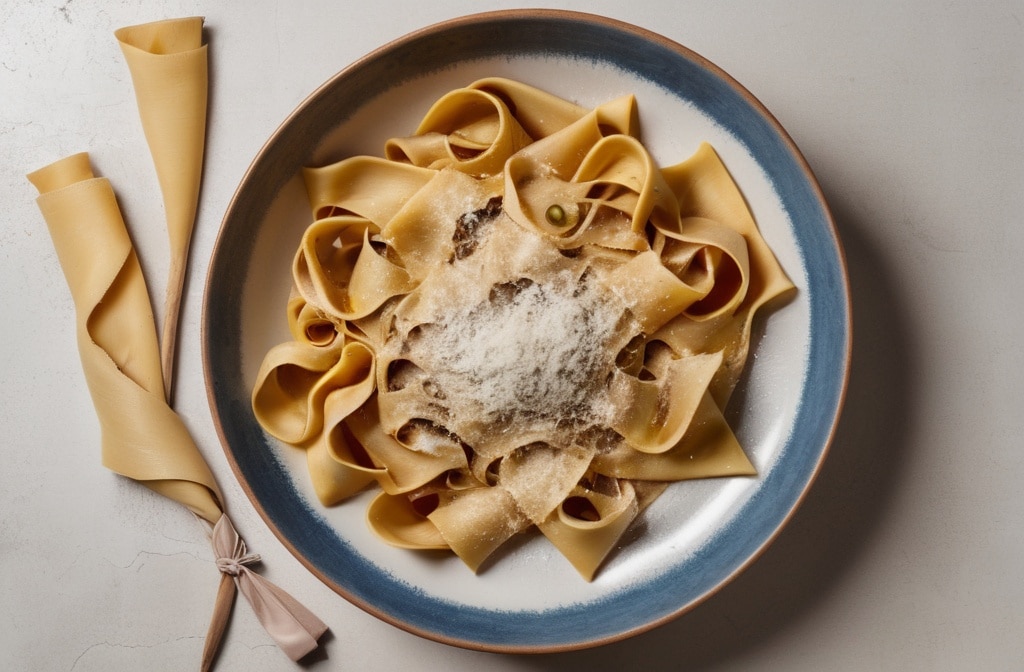Homemade Pappardelle. God, there’s something about cutting that first silky ribbon of dough—fat and floppy and full of promise-that makes you feel like a magician. Or maybe like a little old Italian nonna with arms like tree trunks and a heart made of garlic and olive oil.
Homemade Pappardelle isn’t just pasta. It’s wide, luxurious strands of fresh egg dough that catch every bit of sauce like a greedy child. It’s rustic and elegant all at once. It’s the kind of pasta that doesn’t whisper. It sings.
Homemade Pappardelle is traditionally made with just flour and eggs, but don’t let the simplicity fool you. This ain’t store-bought spaghetti. This is the kind of dish that requires your hands, your time, and your love. And what do you get in return? Magic. Straight-up edible magic.
Ingredients & Substitutions
Homemade Pappardelle begins with flour. But not just any flour. Use Tipo 00 flour if you can—fine, powdery, almost like baby talc. It gives your dough that luxurious smoothness. No 00? Use all-purpose, sure, but sift it. Be gentle.
Homemade Pappardelle needs eggs. Whole eggs. And more yolks. I use 2 whole eggs plus 4 yolks for every 2 cups of flour. That extra fat from the yolks makes the dough richer, more elastic. It’s the difference between silk and a bedsheet.
Homemade Pappardelle can be adjusted for dietary needs. Allergic to eggs? Try aquafaba (yes, chickpea water) or even silken tofu. It’s not gonna be the same, but it’ll get you close. Gluten-free? Blend rice flour with tapioca and xanthan gum. Tweak the hydration. Listen to the dough.
Homemade Pappardelle is best with a drizzle of good olive oil in the dough. Just a smidge. Like a teaspoon. Some say it’s unnecessary. I say it gives the dough soul.

Step-by-Step Instructions
Homemade Pappardelle starts with a mound. Pour your flour onto a wooden board—yes, wooden. Make a well. Crack in your eggs and yolks. Start mixing with a fork, slow spirals. Don’t rush it. Let the flour fall in like a landslide.
Homemade Pappardelle needs kneading. Ten minutes, minimum. Your arms should feel like jelly, but the dough? Smooth, elastic, a little springy. If it’s sticky, dust it. If it’s dry, damp your hands. Don’t pour water. Just damp.
Homemade Pappardelle wants a nap. Wrap the dough tightly and let it rest at room temperature for 30 minutes. Gluten needs time to relax, or you’ll wrestle it later.
Homemade Pappardelle rolls out best in quarters. Don’t roll the whole blob at once unless you’re a masochist. Use a pasta machine if you have one. If not, a rolling pin and grit. Roll to the second-thinnest setting or until it’s see-through like a window in a dream.
Homemade Pappardelle is cut wide. That’s its charm. Use a sharp knife or pizza cutter. Aim for strips ¾ to 1 inch wide. Too narrow, it ain’t pappardelle. Too wide, and you’ve made lasagna’s bohemian cousin.
Homemade Pappardelle wants dusting. Flour the ribbons lightly and nest them in little piles. Don’t let ’em stick or you’ll curse the gods of gluten.
Cooking Techniques & Science
Homemade Pappardelle cooks fast. Fresh pasta doesn’t need more than 2 to 3 minutes in boiling salted water. Taste it—don’t trust the clock. It should be tender but with a bit of chew, like the texture of a dream remembered.
Homemade Pappardelle loves sauces with body. Think wild boar ragù, creamy mushroom sauces, beef short ribs falling apart in red wine. The width of the noodle holds that weight like a pasta superhero.
Homemade Pappardelle thrives on flour type. 00 flour makes it silky. Semolina adds bite. All-purpose is fine in a pinch. Higher protein gives better structure. Lower protein? Softer, more fragile ribbons. Choose your adventure.
Homemade Pappardelle responds to room temperature. Cold dough cracks. Hot dough turns mush. Keep everything cool and steady. Dough should feel like your earlobe. Weird but true.
Homemade Pappardelle hates humidity. Rainy day? Use fewer eggs or more flour. Or just wait. Dough can be a diva like that.
Homemade Pappardelle benefits from resting post-roll. Let the cut pasta sit out for 10–15 minutes before boiling. Helps it firm up a little. Keeps it from becoming mush in the pot.
Serving & Pairing Suggestions
Homemade Pappardelle deserves a stage. Don’t hide it under sauce. Toss it gently, coat it evenly. Let the ribbons shine. Use a wide, shallow bowl. Give it room to breathe.
Homemade Pappardelle loves earthy flavours. Pair it with mushroom ragù, truffle oil, and roasted garlic. Add chopped herbs at the end—parsley, chives, maybe tarragon if you’re bold.
Homemade Pappardelle plays well with drinks. A rich Barolo, Chianti Classico, or even a good buttery Chardonnay if you’re doing creamy sauces. Want a wild twist? Lambrusco. Cold. Fizzy. Cuts the richness like a knife.
Homemade Pappardelle makes a meal. Serve with grilled radicchio, fennel salad, or just crusty bread and good butter. No need to get fancy. Let the pasta do the talking.

Conclusion
Homemade Pappardelle is a ritual. A celebration. It’s messy, slow, and completely worth it. You’re not just making dinner. You’re creating art with flour and eggs and your two damn hands.
Homemade Pappardelle teaches patience. Teaches respect. Teaches you to listen to dough, to texture, to tradition. It humbles you. And then feeds you.
Homemade Pappardelle is one of those recipes you’ll make again and again. Not because it’s quick. But because every time you do, it feels a little more like coming home.
Make it once and you’ll see.
Make it twice and you’ll understand.
Make it a third time… and you’ll never go back to boxed noodles again.
FAQs
Can I freeze homemade pappardelle?
Yes. Lay the ribbons flat on a floured tray. Freeze till solid. Then toss into a bag and freeze up to 2 months. Boil straight from frozen. Just add 1 minute to the cook time.
Why is my pappardelle dough too dry or too wet?
Flour absorbs moisture differently depending on humidity, egg size, and even brand. Too dry? Add a teaspoon of water at a time. Too wet? Dust with flour. Trust your hands, not just the recipe.
Do I need a pasta machine?
Nope. It helps, sure. Makes life easier. But you can roll by hand. You’ll sweat, swear, and maybe cry a little. But it’ll work. And it’ll taste just as good—maybe even better.
What’s the best sauce for pappardelle?
Heavy, chunky, rich sauces. Think slow-cooked meats, mushrooms, and cream-based sauces. Avoid thin tomato sauces—they’ll slide right off like a bad date.
How thick should I roll pappardelle?
Aim for about 1.5mm thick. Not too paper-thin. You want a body. If you can see your hand through it like stained glass, you’re good.

Olivia P. is a seasoned food blogger at Tastywink, sharing delicious, easy-to-follow recipes inspired by him passion for home cooking. With years of culinary blogging experience, he brings flavor, creativity, and a personal touch to every dish.
